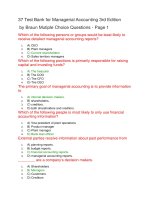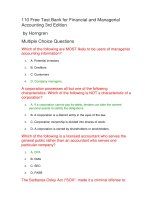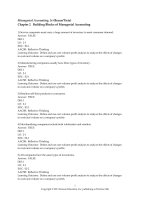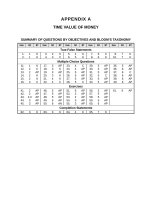Financial managerial accounting 3rd kieso ch20(incremental analysis)
Bạn đang xem bản rút gọn của tài liệu. Xem và tải ngay bản đầy đủ của tài liệu tại đây (220.97 KB, 49 trang )
Financial & Managerial
Accounting
3rd Edition
Weygandt Kimmel Kieso
Chapter 20
Incremental Analysis
Chapter Outline
Learning Objectives
LO 1 Describe management’s decision-making process and
incremental analysis.
LO 2 Analyze the relevant costs in accepting an order at a special
price.
LO 3 Analyze the relevant costs in a make-or-buy decision.
LO 4 Analyze the relevant costs and revenues in determining
whether to sell or process materials further.
LO 5 Analyze the relevant costs to be considered in repairing,
retaining, or replacing equipment.
LO 6 Analyze the relevant costs in deciding whether to eliminate
an unprofitable segment or product.
Copyright ©2018 John Wiley & Son, Inc.
2
Decision-Making
Making decisions is an important management
function.
Does not always follow a set pattern
Decisions vary in scope, urgency, and importance
Steps usually involved in process include:
1. Identify the problem and assign responsibility
2. Determine and evaluate possible courses of
action
3. Make a decision
LO 1
Copyright ©2018 John Wiley & Son, Inc.
4. Review results
of the decision
3
Decision-Making Process
In making business decisions,
Considers financial and non-financial information
Financial information
Revenues and costs, and
Effect on overall profitability
a. Nonfinancial information
Effect on employee turnover
The environment
Overall company image
LO 1
Copyright ©2018 John Wiley & Son, Inc.
4
Incremental Analysis Approach
a. Decisions involve a choice among alternative
actions
b. Process used to identify the financial data that
change under alternative courses of action
LO 1
Both costs and revenues may vary or
Only revenues may vary or
Only costs may vary
Copyright ©2018 John Wiley & Son, Inc.
5
How Incremental Analysis Works
ILLUSTRATION 20.2
Basic approach in incremental analysis
Alternative A
Revenues
$125,000
Costs
100,000
Net income
$25,000
Net Income
Increase
Alternative B (Decrease)
$110,000
$(15,000)
80,000
20,000
$30,000
$5,000
a. Incremental revenue is $15,000 less under
Alternative B
b. Incremental cost savings of $20,000 is realized
c. Alternative B produces $5,000 more net income
LO 1
Copyright ©2018 John Wiley & Son, Inc.
6
How Incremental Analysis Works
Important concepts used in incremental analysis:
a. Relevant cost
b. Opportunity cost
c. Sunk cost
LO 1
Copyright ©2018 John Wiley & Son, Inc.
7
How Incremental Analysis Works
a. Sometimes involves changes that seem contrary to
intuition
b. Variable costs sometimes do not change under
alternatives
c. Fixed costs sometimes change between alternatives
LO 1
Copyright ©2018 John Wiley & Son, Inc.
8
Types of Incremental Analysis
Common types of decisions involving incremental
analysis:
1. Accept an order at a special price
2. Make or buy component parts or finished products
3. Sell or process further them further
4. Repair, retain, or replace equipment
5. Eliminate an unprofitable business segment or
product
LO 1
Copyright ©2018 John Wiley & Son, Inc.
9
Incremental Analysis
Incremental analysis is the process of identifying
the financial data that
a. Do not change under alternative courses of
action
b. Change under alternative courses of action
c. Are mixed under alternative courses of
action
d. None of the above
LO 1
Copyright ©2018 John Wiley & Son, Inc.
10
DO IT! 1 Incremental Analysis (1 of 2)
Using the contribution margin technique, compute the break-even
point in Owen T Corporation is comparing two different options.
The company currently operates under Option 1, with revenues of
$80,000 per year, maintenance expenses of $5,000 per year, and
operating expenses of $38,000 per year. Option 2 provides
revenues of $80,000 per year, maintenance expenses of $12,000
per year, and operating expenses of $32,000 per year. Option 1
employs a piece of equipment that was upgraded 2 years ago at a
cost of $22,000. If Option 2 is chosen, it will free up resources that
will increase revenues by $3,000.
Complete the following table to show the change in income from
choosing Option 2 versus Option 1. Designate any sunk costs with
an “S.”
LO 1
Copyright ©2018 John Wiley & Son, Inc.
11
DO IT! 1 Incremental Analysis (2 of 2)
Complete the following table to show the change in income from
choosing Option 2 versus Option 1. Designate any sunk costs with
an “S.”
Net Income
Option 1
Revenues
$80,000
Maintenance expenses
5,000
Operating expenses
38,000
Equipment upgrade
22,000
Opportunity cost
3,000
LO 1
Option 2
$80,000
12,000
32,000
0
0
Copyright ©2018 John Wiley & Son, Inc.
Increase
(Decrease) Sunk (S)
$0
(7,000)
6,000
0
S
3,000
$ 2,000
12
Special Orders
a. To obtain additional business by making a major
price concession to a specific customer
b. Assumes that sales of products in other markets are
not affected by special order
c. Assumes that company is not operating at full
capacity
LO 2
Copyright ©2018 John Wiley & Son, Inc.
13
Special Orders
Sunbelt Company produces 100,000 Smoothie
blenders per month, which is 80% of plant capacity.
Variable manufacturing costs are $8 per unit. Fixed
manufacturing costs are $400,000, or $4 per unit. The
Smoothie blenders are normally sold directly to
retailers at $20 each. Sunbelt has an offer from
Kensington Co. (a foreign wholesaler) to purchase an
additional 2,000 blenders at $11 per unit. Acceptance
of the offer would not affect normal sales of the
product, and the additional units can be
manufactured without increasing plant capacity.
LO 2
Copyright ©2018 John Wiley & Son, Inc.
14
Special Orders
Revenues
Costs
Net income
Reject Order
$0
0
$0
ILLUSTRATION 20.4
Incremental analysis—accepting an order at a special price
Accept Order
$22,000
16,000
$6,000
Net Income
Increase
(Decrease)
$22,000
(16,000)
$6,000
a. Fixed costs do not change since within existing capacity
– thus fixed costs are not relevant
b. Variable manufacturing costs and expected revenues
change – thus both are relevant to the decision
LO 2
Copyright ©2018 John Wiley & Son, Inc.
15
DO IT! 2 Special Orders
Cobb Company incurs costs of $28 per unit ($18 variable and $10
fixed) to make a product that normally sells for $42. A foreign
wholesaler offers to buy 5,000 units at $25 each. The special order
results in additional shipping costs of $1 per unit. Compute the
increase or decrease in net income Cobb realizes by accepting the
special order, assuming Cobb has excess operating capacity.
Net Income
Should Cobb Company accept the special order?
Increase
Reject Order
Accept Order
(Decrease)
Revenues
$0
$125,000
$125,000
Costs
0
95,000
(95,000)
Net income
$0
$30,000
$30,000
LO 2
Copyright ©2018 John Wiley & Son, Inc.
16
Make or Buy
Illustration: Baron Company incurs the following annual costs
in producing 25,000 ignition switches for motor scooters.
Direct materials $ 50,000
Direct labor 75,000
Variable manufacturing overhead 40,000
Fixed manufacturing overhead 60,000
Total manufacturing costs
$225,000
Total cost per unit ($225,000 ÷ 25,000) $9.00
Instead of making switches, Baron might purchase ignition
switches at a price of $8 per unit. What should Baron do?
LO 3
Copyright ©2018 John Wiley & Son, Inc.
17
Make or Buy
ILLUSTRATION 19.6
Incremental analysis—make or buy
Make
Direct materials
$50,000
Direct labor
75,000
Variable manufacturing costs
40,000
Fixed manufacturing costs
60,000
Purchase price (25,000 × $8)
0
Total annual cost
$225,000
Buy
$0
0
0
50,000
200,000
$250,000
Net Income
Increase
(Decrease)
$50,000
75,000
40,000
10,000
(200,000)
$(25,000)
• Manufacturing cost is $1 higher per unit than purchase price
• Must absorb at least $50,000 of fixed costs under either option
LO 3
Copyright ©2018 John Wiley & Son, Inc.
18
Make or Buy Decision
In a make-or-buy decision, relevant costs are:
a. Manufacturing costs that will be saved
b. The purchase price of the units
c. Opportunity costs
d. All of the above
LO 3
Copyright ©2018 John Wiley & Son, Inc.
19
Opportunity Cost
The lost potential benefit that could have been
obtained from following an alternative course of
action.
In the make-or-buy decision, it is important for
management to take into account the social impact of
its choice.
LO 3
Copyright ©2018 John Wiley & Son, Inc.
20
Opportunity Cost
Illustration: Assume that through buying the switches, Baron
Company can use the released productive capacity to generate
additional income of $38,000 from producing a different product.
This lost income is an additional cost of continuing to make the
switches in the make-or-buy decision.
Net Income
Increase
(Decrease)
Make
Buy
Total annual cost
Opportunity cost
Total cost
$225,000
38,000
$263,000
$250,000
0
$250,000
$(25,000)
38,000
$13,000
ILLUSTRATION 19.7
Incremental analysis—make or
buy, with opportunity cost
LO 3
Copyright ©2018 John Wiley & Son, Inc.
21
DO IT! 3 Make or Buy (1 of 3)
Juanita Company must decide whether to make or buy some of its
components for the appliances it produces. The costs of producing
166,000 electrical cords for its appliances are as follows.
Direct materials $90,000 Variable overhead
$32,000
Direct labor 20,000
Fixed overhead 24,000
Instead of making the electrical cords at an average cost per unit of
$1.00 ($166,000 ÷ 166,000), the company has an opportunity to
buy the cords at $0.90 per unit. If the company purchases the
cords, all variable costs and one-fourth of the fixed costs will be
eliminated.
LO 3
Copyright ©2018 John Wiley & Son, Inc.
22
DO IT! 3 Make or Buy (2 of 3)
a. Prepare an incremental analysis showing
whether the company should make or buy the
electrical cords.
Make
Buy
Direct materials
$ 90,000
Direct labor
20,000
Variable manufacturing costs
32,000
Fixed manufacturing costs
24,000
Purchase price
–0–
Total cost
$166,000
Net Income
Increase
(Decrease)
$ –0–
$90,000
–0–
20,000
–0–
32,000
18,0001
6,000
149,4002 (149,400)
$167,400
$ (1,400)
$24,000 × .75
166,000 × $0.90
1
2
LO 3
Copyright ©2018 John Wiley & Son, Inc.
23
DO IT! 3 Make or Buy (3 of 3)
b. Will your answer be different if the released
productive capacity will generate additional
income of $5,000?
Make
Buy
Total cost
Opportunity cost
Total cost
$ 166,000 $ 167,400
5,000
0
$171,000 $167,400
Net Income
Increase
(Decrease)
$(1,400)
5,000
$3,600
Yes, net income will be increased by $3,600 if Juanita Company
purchases the electrical cords rather than making them.
LO 3
Copyright ©2018 John Wiley & Son, Inc.
24
Sell or Process Further
May have option to sell product at a given point in
production or to process further and sell at a higher
price.
Decision Rule:
a. Process further as long as the incremental revenue
from such processing exceeds the incremental
processing costs
LO 4
Copyright ©2018 John Wiley & Son, Inc.
25









